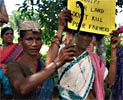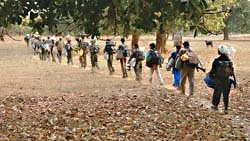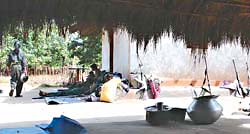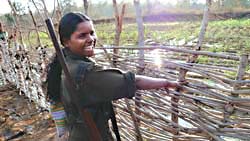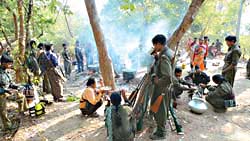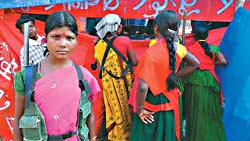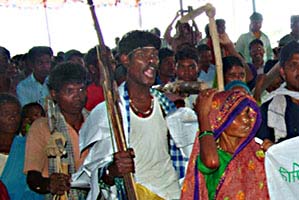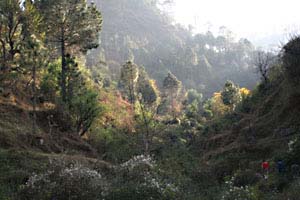Arundhati Roy With the Guerillas
roaming around in the forest for several weeks
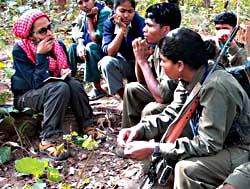 Journalist-writer Arundhati Roy talking with the guerillas.
Journalist-writer Arundhati Roy talking with the guerillas.
The famous Indian writer and journalist Arundhati Roy traveled around with the Maoists in the forests of the center Indian state Chhattisgarh for
several weeks. The guerillas are mostly young tribals (women and men) fighting against oppression and displacement for dams and mines
and for their autonomy as small farmers with their own local culture.
Download the whole article (in Word, 1.5 MB) or
go the article in Outlook
Roy: The antagonists in the forest (of the government and companies) are disparate and unequal in almost every way. On one side is a massive paramilitary
force armed with the money, the firepower, the media, and the hubris of an emerging Superpower. On the other, ordinary villagers armed with
traditional weapons, backed by a superbly organised, hugely motivated Maoist guerrilla fighting force with an extraordinary and violent history
of armed rebellion.
(..) It's easier on the liberal conscience to believe that the war in the forests is a war between the Government of India and the Maoists, who call
elections a sham, Parliament a pigsty and have openly declared their intention to overthrow the Indian State. It's convenient to forget that
tribal people in Central India have a history of resistance that predates Mao by centuries. The Ho, the Oraon, the Kols, the Santhals, the
Mundas and the Gonds have all rebelled several times, against the British, against zamindars (big land lords) and moneylenders. The rebellions
were cruelly crushed, many thousands killed, but the people were never conquered.
(..) Each time it needed to displace a large population—for dams, irrigation projects, mines—the government talked of "bringing tribals into the
mainstream" or of giving them "the fruits of modern development". Of the tens of millions of internally displaced people (more than 30 million by
big dams alone), refugees of India's 'progress', the great majority are tribal people.
(..) Over the past five years or so, the governments of Chhattisgarh (Center Indian state), Jharkhand, Orissa and West Bengal (East Indian states)
have signed hundreds of MoUs (Memorandums of Understanding = informal agreements) with corporate houses, worth several billion dollars, all of them secret,
for steel plants, sponge-iron factories, power plants, aluminium refineries, dams and mines. In order for the MoUs to translate into real money, tribal
people must be moved. Therefore, this war.
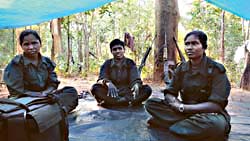 Guerillas in their camp in the forest.
Guerillas in their camp in the forest.
(..) Who are the Maoists? Are they just violent nihilists foisting an outdated ideology on tribal people, goading them into a hopeless insurrection? What
lessons have they learned from their past experience? Is armed struggle intrinsically undemocratic? Is the Sandwich Theory—of 'ordinary' tribals being
caught in the crossfire between the State and the Maoists—an accurate one?
(..) It's the most beautiful room I have slept in, in a long time. My private suite in a thousand-star hotel. I'm surrounded by these strange, beautiful
children with their curious arsenal. They're all Maoists for sure. Are they all going to die? Is the jungle warfare training school for them? And the
helicopter gunships, the thermal imaging and the laser range-finders?
Why must they die? What for? To turn all of this into a mine? I remember my visit to the open cast iron-ore mines in Keonjhar, Orissa. There was
forest there once. And children like these. Now the land is like a raw, red wound. Red dust fills your nostrils and lungs. The water is red, the air
is red, the people are red, their lungs and hair are red. All day and all night trucks rumble through their villages, bumper to bumper, thousands and
thousands of trucks, taking ore to Paradip port from where it will go to China. There it will turn into cars and smoke and sudden cities that spring up
overnight. Into a 'growth rate' that leaves economists breathless. Into weapons to make war.
(..) We're moving in single file now. Myself and one hundred "senselessly violent", "bloodthirsty" insurgents. I looked around at the camp before we
left. There are no signs that almost a hundred people had camped here, except for some ash where the fires had been. I cannot believe this army. As far
as consumption goes, it's more Gandhian than any Gandhian, and has a lighter carbon footprint than any climate change evangelist. But for now, it even has
a Gandhian approach to sabotage; before a police vehicle is burnt, for example, it is stripped down and every part cannibalised.
(..) We're walking in pitch darkness and dead silence. I'm the only one using a torch, pointed down so that all I can see in its circle of light are Comrade
Kamla's bare heels in her scuffed, black chappals, showing me exactly where to put my feet. She is carrying 10 times more weight than I am. Her backpack, her
rifle, a huge bag of provisions on her head, one of the large cooking pots and two shoulder bags full of vegetables. The bag on her head is perfectly balanced,
and she can scramble down slopes and slippery rock pathways without so much as touching it. She is a miracle.
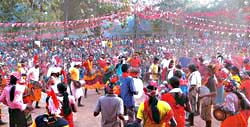 Dancing at the Maoist festival in the middle of the forest.
Dancing at the Maoist festival in the middle of the forest.
There was a big festival in the forest.
(..) Another troupe from south Gangalaur performs a play called Nitir Judum Pito (Story of the Blood Hunt). Joori translates for me. It's the story of
two old people who go looking for their daughter's village. As they walk through the forest, they get lost because everything is burnt and unrecognisable. The
Salwa Judum (Peace Hunt, local terrorist group of the government) has even burned the drums and the musical instruments. There are no ashes because it
has been raining. They cannot find their daughter. In their sorrow, the old couple starts to sing, and hearing them, the voice of their daughter sings
back to them from the ruins: the sound of our village has been silenced, she sings. There's no more pounding of rice, no more laughter by the well. No more
birds, no more bleating goats. The taut string of happiness has been snapped.
(..) Comrade Niti and Comrade Vinod lead us on a long walk to see the series of water-harvesting structures and irrigation ponds that have been built
by the local Janatana Sarkar (= People's Government). Comrade Niti talks about the range of agricultural problems they have to deal with. Only 2 per
cent of the land is irrigated. In Abujhmad, ploughing was unheard of until 10 years ago. In Gadchiroli on the other hand, hybrid seeds and chemical pesticides
are edging their way in. "We need urgent help in the agriculture department," Comrade Vinod says. "We need people who know about seeds, organic pesticides,
permaculture. With a little help we could do a lot."
(..) I think of what Comrade Venu said to me: they want to crush us, not only because of the minerals, but because we are offering the world an alternative
model. It's not an Alternative yet, this idea of Gram Swaraj (People's Democracy + Autonomy) with a Gun. There's too much hunger, too much sickness here. But
it has certainly created the possibilities for an alternative for this region. It's the world's best-kept secret. It has laid the foundations for an
alternative to its own annihilation. It has defied history. Against the greatest odds it has forged a blueprint for its own survival. It needs help and
imagination, it needs doctors, teachers, farmers. It does not need war. But if war is all it gets, it will fight back.
(..) Sukhiari, who as a child was abducted and forcibly married to an older man (she ran away and went to live with her sister), now organises mass
rallies, speaks at meetings. The men depend on her for protection. I asked her what the party means to her. "Naxalvaad ka matlab hamara parivaar
(Naxalvaad means our family). When we hear of an attack, it is like our family has been hurt," Sukhiari says.
(..) I met Chamri, mother of Comrade Dilip who was shot on July 6, 2009. She says that after they killed him, the police tied her son's body to a
pole, like an animal and carried it with them. Picture this mother for a moment, following her son's corpse through the forest, stopping at a
distance to wait for his murderers to finish their tea. They did not let her have her son's body back so she could give him a proper funeral. They
only let her throw a fistful of earth in the pit in which they buried the others they had killed that day. Chamri says she wants revenge. Badla ku
badla. Blood for blood.
(..) They described a police raid: they come at night, 300, 400, sometimes 1,000 of them. They lay a cordon around a village and lie in wait. At dawn
they catch the first people who go out to the fields and use them as human shields to enter the village, to show them where the booby-traps
are. ('Booby-traps' has become a Gondi word. Everybody always smiles when they say it or hear it. The forest is full of booby-traps, real and
fake. Even the PLGA needs to be guided past villages.) Once the police enter a village, they loot and steal and burn houses. They come with dogs. The dogs
catch those who try and run. They chase chickens and pigs and the police kill them and take them away in sacks. SPOs (Special Police Officers,
local people) come along with the police. They're the ones who know where people hide their money and jewellery. They catch people and take them
away. And extract money before they release them. They always carry some extra Naxal 'dresses' with them in case they find someone to kill. They
get money for killing Naxals, so they manufacture some.
(..) On my last few days, we meander through the lush, beautiful Indravati valley. As we walk along a hillside, we see another line of people walking
in the same direction, but on the other side of the river. I'm told they are on their way to an anti-dam meeting in Kudur village. They're overground
and unarmed. A local rally for the valley. I jump ship and join them.
The Bodhghat dam will submerge the entire area that we have been walking in for days. All that forest, all that history, all those stories. More than
100 villages. Is that the plan then? To drown people like rats, so that the integrated steel plant in Lohandiguda and the bauxite mine and aluminium
refinery in the Keshkal ghats can have the river?
At the meeting, people who have come from miles away say the same thing we have all heard for years. We will drown, but we
won't move! They are thrilled that someone from Delhi is with them. I tell them Delhi is a cruel city that neither knows nor
cares about them.
(..) At dawn, I say goodbye to Comrade Madhav and Joori, to young Mangtu and all the others. Comrade Chandu has gone to organise the bikes, and will
come with me to the main road. As we start walking, Niti and Sukhdev casually but simultaneously unclick the safety catches of their AKs. It's the first
time I've seen them do that. We're approaching the 'Border'. "Do you know what to do if we come under fire?" Sukhdev asks casually, as though it was the
most natural thing in the world.
"Yes," I said, "immediately declare an indefinite hunger strike."
He sat down on a rock and laughed. We climbed for about an hour. Just below the road, we sat in a rocky alcove, completely concealed, like an ambush party,
listening for the sound of the bikes. When it comes, the farewell must be quick. Lal Salaam (Red Greetings) Comrades.
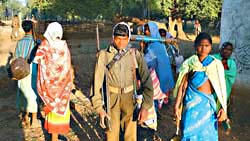 Village militia, the 'base force' of the People's Liberation Guerrilla Army
Village militia, the 'base force' of the People's Liberation Guerrilla Army
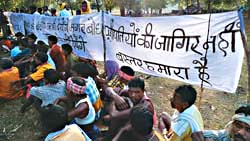 People of Kudur village protest the Bodhghat dam: 'It does not belong to the capitalists, Bastar is Ours'y
People of Kudur village protest the Bodhghat dam: 'It does not belong to the capitalists, Bastar is Ours'y
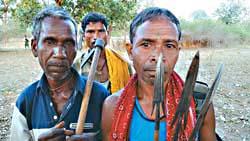 Villagers from the submergence area.
Villagers from the submergence area.
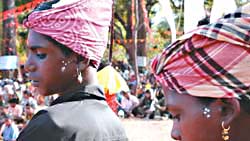 Adivasi boys in colourful traditional gear for Maoist festival in the middle of the forest.
Adivasi boys in colourful traditional gear for Maoist festival in the middle of the forest.
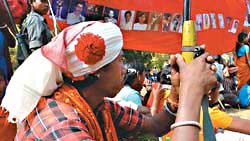 Pictures of slain comrades displayed on the festival.
Pictures of slain comrades displayed on the festival.
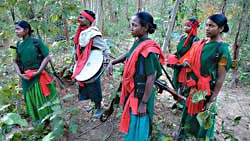 Members of cultural wing of the party, waiting in the wings
Members of cultural wing of the party, waiting in the wings
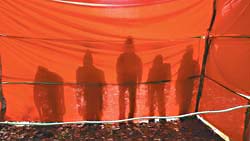 Protecting the people on the festival.
Protecting the people on the festival.
Download the whole article (in Word, 1.5 MB)
Go the article in Outlook
Go to next page: Amitav Ghosh - Bon Bibi legend, 'ethnic cleansing' of India's forests
Go to overview issues or to overview reports
